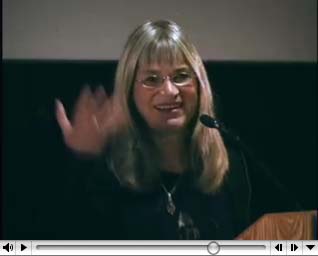
RETHINKING DEVELOPMENT
Local Pathways to Global Wellbeing
St. Francis Xavier University, Antigonish, Nova Scotia, Canada
June 20 to June 24, 2005
PLENARY: Environmental Preservation
What is Sustainable and What is Not
Holly Dressel


You wouldn’t be here if you all hadn’t been grappling with these problems and with one particular question: How can we live sustainably?
That question demands that we know what sustainability is, and what it isn’t. I think we can agree that sustainability means being able to support ourselves and provide for our human needs without destroying the systems that will produce more timber, food and water, for example, for us and our children in the future. That means we have to be able to look at a management method, say of growing crops, and determine whether people can keep growing enough food in that particular way to feed themselves almost indefinitely, without destroying the systems—water, air, soil and biodiversity—on which the whole enterprise depends. We have to be able to look at new fuel sources or construction methods and determine whether they tip the scales in favour of the planet’s regeneration, or whether they strip it too fast or whether they, too, leave too many wastes and poisons in their wake. We’ve never had to do this exercise so urgently before. And it’s easy to go astray.
For example, how many people know whether ethanol, or even biodiesel, for example, really are much better fuel sources than oil or natural gas? It’s debatable, you know. Is it really better for the earth to have intensively grown, bioengineered crops, so that more land can remain in wilderness condition, like the biotech companies tell us? These are difficult questions, and human beings can so easily go awry. Some of you may be old enough to remember how many people of good will really thought that nuclear power would provide a clean source of energy, freeing us from coal and oil. We all thought CFCs were harmless—who could ever imagine that a spray perfume or deodorant could punch holes in the very atmosphere and alter life on this planet? So—given all that—how are we to tell if promising new technologies and methodologies are going to help the planet, or only delay the inevitable (which frankly is almost as bad) or even push us over the brink faster?
I took this problem very seriously when David Suzuki and I began to write our last book, Good News for a Change. I was terrified there would be no way to recognize the right way from the wrong. The very good news is there are actually six simple criteria you can use to help you figure out whether or not what you want to do is going to work over the long term. I didn’t discover them, mind you—people working absolutely from the grassroots, and I mean poor farmers, ranchers, villagers, housewives, construction workers, people like that—they discovered them. I just recognized what they had in common, and then realized other people, like Alan Savory, who we’ll have the honour of meeting later in this conference, or Bill McDonough, an environmental architect, had also taped out similar criteria. So I knew I’d gotten it right.
Here we go. Got a pencil?
1. First of all. Does your method of gardening, building, dealing with wastes or building up your local community try to mirror natural systems, mimic nature’s methods of production? That means that they should produce no wastes that are not reusable, either by nature itself or by being reused in industry. It means they should provide double dividends—benefits that increase and multiply, as nature does, instead of present and future risks that can only be rationalized as “worth it” for some temporary benefit. Moreover, across the planet, natural systems change every few miles, or less. They support different animals and plants, exhibit different soil types and micro-climates. They are profoundly varied. We found that sustainable groups are nearly always locally-based or working in close contact with local people. That immediately should enable us to judge how well our new globalized economy is going to work out.
2. If you’re going to work locally, with local people and groups, the first thing you’ll find out is you’re going to have to listen to each other, which means working in a basically egalitarian and democratic manner. You’ll hear about it from your local workers if you don’t share workloads and benefits pretty equally, believe me. I can give examples from the terrace farms of Bali to one of North America’s largest private timber companies, that the local and democratic approach will stabilize your management situation not just for years, but for centuries. This also means that benefits will not only be generated by local workers for use elsewhere; they have to be received by these same long-term, local users, not short-term outside interests. Again, what I’m suggesting in both cases, waste re-use and locality, is the opposite of the industrial business pattern being forced on most communities today, but it is resisted often enough I can give you example after example, as can my fellow speakers.
3. Here’s my favourite part of sustainability criteria, and when I first ran into it, I thought it was rather superficial and marginal, to say nothing of a little wet. I was wrong—it’s the heart and soul of the entire subject. And it is: whatever you are doing, make yourself the most positive and idyllic vision statement you can. Think about everything you really want: clean rivers to swim in, good schools and hospitals for everybody, standing forests, good jobs near your community—and make that your goal. As someone sitting up on this dais, Elizabeth May, has taught me, if even you can’t bring yourself to ask for what you want, that pretty much assures you you’ll never get it. The groups I met ranged from completely landless, uneducated fishermen, who wanted control of their entire coastline in southern India; a small town of regular middle-class folks in Germany who wanted to get completely off the fossil fuel power grid; a few Oregon farmers who didn’t want to lose their land, and who wanted to make a long-term living on it by sharing it with mountain lions and wolves. They all made crazily optimistic vision statements. They are all, every one of them, living their dreams, right now. The details are in the book, but there are 1.5 million acres of “predator-friendly” ranchland in Oregon and Washington today; the village of Schoenau in the Black Forest is not only off the grid, but is the major manager of solar and windpower sources for the rest of Germany; the fisherpeople of southern India have control of their fishery. I could go on. So dream big.
4. At the same time, to take probably the most key statement from Alan Savory’s wonderful book, Holistic Management; remain flexible and humble before the complexities of this world. Under his careful criteria for how to foster good pastureland and stock management, for example, are the words: “Assume Wrong.” In other words, if something goes wrong with your carefully planned system of gardening, house building or water management, don’t just step up your efforts and repeat what you’ve been doing. This is typical of most modern management methods. Experts tell farmers to apply petrochemical fertilizers to get more crops; when they get hardpan, that is, dead soil, they’re advised to apply more and to use bigger machines to break up the hardpan. When they get pests from the unhealthy conditions, they’re told to apply more petrochemicals. When the water becomes too polluted to use, new experts come in to tell them to install a water treatment plant. And so forth. Savory’s methods would have us step back at the very first sign of problems and reevaluate, not just the amount of fertilizer we’re using, but the idea of using fertilizer in the first place. When I say flexible and humble, I mean you have to be flexible enough to drop a cherished management idea if it isn’t working out, and humble enough to throw out your own ideas of expertise if the onslaught of bugs or drought or unhappy employees makes it clear that you haven’t quite understood everything you’re up against. Remember, humans beings may be able to split the atom and clone sheep; both these technically dazzling accomplishments turned out to be dangerous and unusable, by the way, because they don’t take into account all the intricacies of our interwoven natural systems.
So: big dreams for all. Humility for your own ideas.
5. We discovered that most of the people who have developed the new methodologies you will hopefully learn about in the next few days don’t know about each other—that’s one reason we’re having this conference. And although many in the agricultural field were aware of Savory’s work, most have evolved these methods on their own. These are ideas that are welling up spontaneously all over the world, the way profound societal change always does. So look at where your management ideas are coming from. They should usually come from the bottom up, not the top down. Again, the local, natural and humble side of sustainability comes into play. Most of these ideas came from grassroots people on the edge of economic stability: in other words, not from governments, universities, institutions or even environmental NGOs. Not from paid “experts,” but from local people who are very motivated to figure out new ways to manage their economies and lives, purely so they can survive and remain where they are, with their families and traditions. In the same vein, once an idea gets beyond a few individuals, they almost always set up working groups that work by consensus; not by majority vote or even by having empowered elected representatives, you understand, but by real consensus, hammering through the issues until all the parties who live in the town agree, because they have to not only live with these decisions, but with each other. These decisions can take, obviously, a long time to make. It took the small city of Frieburg, in Germany, 10 years to achieve consensus on having a car-free core. But once such decisions are made, they’re remarkably stable and sustainable. And by the way: what’s the hurry? Time usually only improves our ability to assess a new technology or idea.
6. Finally, when you’re looking at the pure economics of how you want to live, learn to compare short-term gains with long-term effects. This method will make both the dangers and advantages of each approach abundantly clear. Say a small town is being approached to develop a woodland for an industry that will provide, typically, a few local jobs over, at most, maybe twenty or thirty years before the timber is gone or the mill is outdated. If the town has a vision of its future as a clean and happy community; if it works with humility and by consensus; and if it looks at the short-term gains of the few jobs against its desire to keep some natural systems available to its citizens forever, the decision becomes a lot easier to make. If officials are elected in terms of their ability to administer an already standing long-term vision, as they are in many German towns, as opposed to fulfilling a two or four-year short-term spurt of economic growth, as they generally are here in Canada, the entire role of a politician changes.
Those are the criteria. You can get them through the book, and we can post this little speech on the conference website. Don’t forget about them, and let me know when they don’t work out, so I can be humble and flexible too!
Print PDF (76K)
1.7 minutes
(2.9 MB)

Overview :: Presenters :: Proceedings :: Papers :: Home
Sealevel